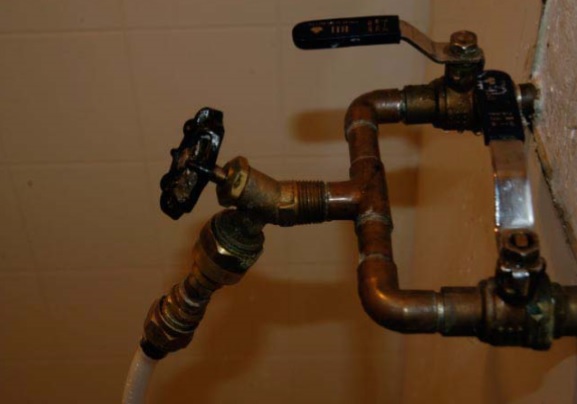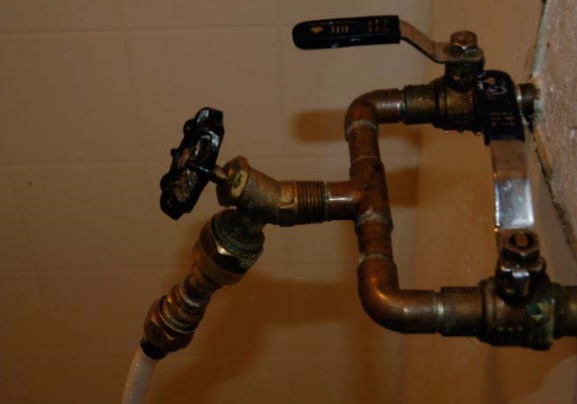Purpose: To determine the Copper concentration of a sample. Testing will be done on a Local Community Treated Water sample and a Canadian Guideline Limit Sample for quality control purposes:
Determination will be done by using a test strip method. You will see if the Local Community Treated Water meets the Canadian Drinking Water Guidelines. Copper is naturally present in the environment, but the levels of contamination can be increased around agricultural land (manure spreading), near smelting facilities, and phosphate fertilizer plants, there is also significant amounts of copper released from wastewater treatment plants. The copper piping in most buildings that we consume water from also can contribute to our intake, depending on the corrosiveness of the water. Copper is essential to good human health but we don’t have to concern ourselves with not getting enough copper, it is present in the food we eat, the air we breathe (more so around large manufacturing plants and industries), and the water we drink. We can, however, consume too much copper and some of the possible negative health effects of excess copper are dizziness, vomiting, diarrhea, upset stomachs, and headaches. A 1 mg/L Canadian Guideline Limit sample will be included for quality control purposes; this is also the limit for copper according to the Canadian Drinking Water Guidelines.
Materials:
• 1 - 1 mg/L Canadian Guideline Limit sample (Copper Standard).
• 2 - Test strip packets, with colour charts printed on them.
• 2 - 10 mL disposable beakers.
Method:
Label the two beakers CGLS and Local.
Put 10 mL of sample in their respective beakers.
Dip one test strip in sample or (CGLS) beaker for 30 seconds with constant back and forth motion.
Remove and match colour after 2 minutes to determine the Copper concentration in mg/L or parts per million (ppm).
Record Your Results
Results: Compare results to the Canadian Drinking Water Guidelines. The Canadian Guideline should give a result very close to the 1 mg/L guideline; a darker colour means that the water Does Not meet Canadian Drinking Water Guidelines.
Safe Handling of Materials
Caution must be taken at all times when handling any chemicals. Although this test is safe to use in any area, please be cautious with the materials supplied.
Copper Fact Sheet
What is Copper and why do we test for it?
Copper is a metal that is naturally present in the environment, but the levels of contamination can be increased around agricultural land (manure spreading), near smelting facilities, and phosphate fertilizer plants. There are also significant amounts of copper released from waste water treatment plants, which could lead to problems downstream for a community that uses this water as their source water. Farmers and others that rely on small water reservoirs for their water supplies may at times try to control algal blooms with copper sulphate (bluestone), which can increase the copper levels in their water supplies but as copper is taken up by the algae its levels should decline rapidly.
However, the main source of copper comes from household plumbing especially when the water is corrosive. As the copper levels in the water treatment plant is generally acceptable compliance with the Copper Guideline is generally achieved by controlling the corrosiveness of the water in the treatment plant. The corrosiveness of water towards copper is generally highest when the water is acidic (pH less than 7, see pH Test), the Alkalinity is low (see Alkalinity Test), and the Hardness is low (see Hardness Test).
What are the Canadian Drinking Water Guidelines for Copper?
The guidelines state that the level should not exceed 1 mg/L copper. The U.S. Environmental Protection Regulation for copper is 1.3 mg/L. The World Health Organization has established a 2.0 mg/L guidance level.
What are some of the health risks associated with Copper?
Copper is an essential nutrient, required by the body in very small amounts. However, health effects may occur when people are exposed to it above the guideline level. The National Academy of Sciences’ Food and Nutrition Board recommends that children need at least 0.34 mg Copper/day and adults need 0.9 mg copper/day. It also recommends that consumption should not exceed 9 mg copper/day.
The most common health effects of the excessive consumption of copper bearing water would be: nausea, vomiting, diarrhea, upset stomach, and dizziness. If extreme intake of Copper occurs, kidney and liver damage is possible.
What do I do if my water exceeds the Canadian Drinking Water Guidelines?
Since the major contributor to copper in drinking water is the corrosion of the copper pipes, the best way to minimize the problem is to raise the pH of the water to greater than 7.0 so that the piping is not being attacked. Another possibility is the source water may be contaminated by one of the sources previously stated; in that case a more aggressive approach may be needed by the water treatment facility. Actions to ensure that we are not exposed to high levels of copper should all be taken at the drinking water treatment plant.
If the water is corrosive, higher levels of copper can occur when the water sits in plumbing pipes for longer periods, such as overnight. Flushing of the tap water for 30 seconds or more can reduce the copper levels. In the U.S. if a water system fails to comply with the U.S. Environmental Protection Agency Regulation it must notify the public through newspapers, TV etc. Failure to provide a water meeting the Copper Standard may mean that the water supplier needs to supply alternate drinking water supplies.



